Motorola unveils tablet with Honeycomb, Tegra, and (soon) 4G
Jan 6, 2011 — by Eric Brown — from the LinuxDevices Archive — viewsMotorola Mobility announced its long-awaited Android 3.0 (“Honeycomb”) tablet, featuring a dual-core Nvidia Tegra 2 processor. Destined for Verizon, the Xoom is equipped with a 10.1-inch, 1280 x 800 touchscreen, supports 1080p HD video with HDMI output, and, unlike Apple's iPad, offers dual cameras.
When it ships later this quarter, the Motorola Xoom will be the first tablet to reach market with the tablet-focused Android 3.0, which was tipped yesterday in a Google preview video. The Xoom itself has been tipped in various forms for months, with the Xoom name and a few other details emerging last week.
The initial version, supporting Verizon Wireless' 3G network, will ship this quarter, and an upgrade for Verizon's faster 4G LTE network will be available in the second quarter, says Motorola Mobility, the new name for the recently split smartphone/tablet portion of Motorola.
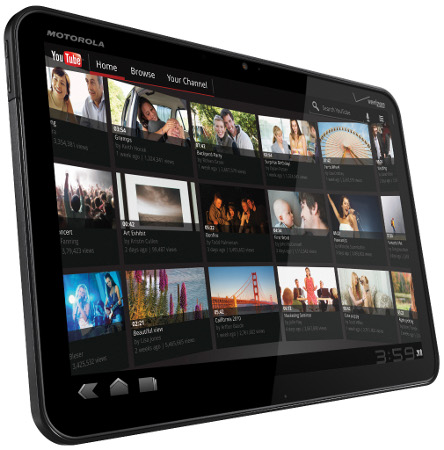
Motorola Xoom
(Click to enlarge)
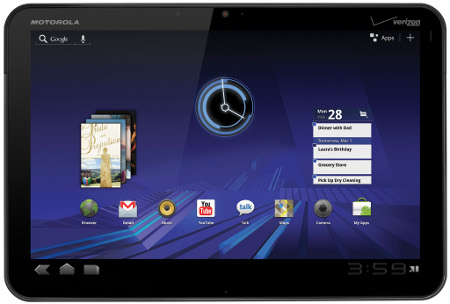
Motorola Xoom showing Android 3.0 UI changes
(Click to enlarge)
In addition to offering support for larger screen sizes and resolutions, Android 3.0 features improved multitasking, an overhauled UI with heavy use of horizontal carousel interfaces, and more of a 3D look and feel.
Motorola notes that the Xoom specifically makes use of Honeycomb's Google Maps 5.0 with 3D interaction, and access to over three million Google eBooks. Other noted features include Android Market access, enhanced Gmail, Exchange email, and the ability to edit documents, spreadsheets, and presentations.
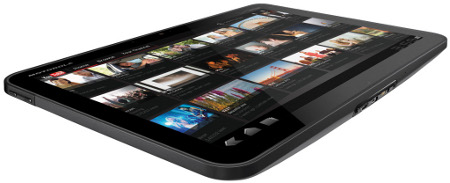
Xoom, side view
(Click to enlarge)
The 10.1-inch, presumably capacitive, display offers an equally generous 1280 x 800 resolution, beating the iPad and just about any Android tablet announced prior to this week's CES.
The display offers 150 dpi, as well as Corning Gorilla Glass for greater durability, says Motorola. Also noted is pinch-to-zoom navigation, and a "radical" new "floating multi-finger interface," although the latter appears to be tied more to Honeycomb than to the tablet itself.
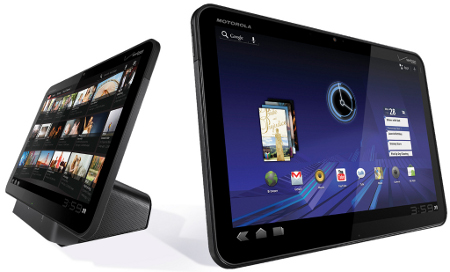
Xoom, on the stand (left) and off
(Click to enlarge)
Motorola does say the tablet supplies a built-in gyroscope, e-compass, accelerometer, and "adaptive lighting." There's even a barometer to prepare one's self for the next pressure drop.
The Xoom provides both a rear-facing five-megapixel camera and a front-facing two-megapixel videocam, a feature not always found on such a large tablet. The five-megapixel camera is said to supply LED flash, digital zoom, and 720p video recording.
An HDMI port is provided to output video at up to 1080p HD quality, and DLNA compatibility means the Xoom can share media with other like-minded devices, says Motorola.
Xoom accessories are said to include:
- mobile hotspot capability for sharing bandwidth with up to five other Wi-Fi-enabled devices
- portfolio case in "durable or leather" with built-in stand (below, right)
- standard charging dock with stand (below, top)
- speaker HD dock with speakers, three USB 2.0 ports, HDMI port, and stand (below, left)
- wireless Bluetooth QWERTY keyboard (below, bottom)
- various chargers, Bluetooth headsets, etc.
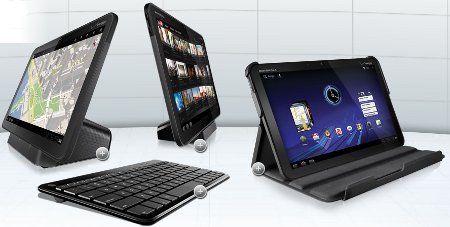
Options, clockwise from top: docking station, case, keyboard, speaker docking station
(Click to enlarge)
Availability
The Motorola Xoom will ship as a 3G/Wi-Fi-enabled device in Q1 2011. An upgrade to 4G LTE is said to be available in Q2, at which point new versions of the Motorola Xoom will be available with 4G LTE, says Motorola Mobility.
More information on the tablet may be found at Motorola's Xoom page.
This article was originally published on LinuxDevices.com and has been donated to the open source community by QuinStreet Inc. Please visit LinuxToday.com for up-to-date news and articles about Linux and open source.